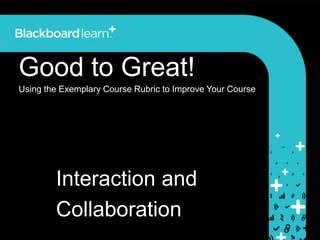Interaction and collaboration workshop presentation
- 1. Good to Great! Using the Exemplary Course Rubric to Improve Your Course Interaction and Collaboration
- 2. Workshop Objective By the end of the workshop, participants will be able to: ŌĆō Identify the elements of interaction and collaboration from the Blackboard Exemplary Course Program Rubric. 2 2
- 3. What is a Learning Community? 3
- 4. Blackboard Exemplary Course Program Exemplary Course Program 4 4
- 5. Exemplary Course Program Rubric Course Design Interaction and Collaboration Assessment Learner Support 5
- 6. Interaction and Collaboration Communication Strategies Development of Learning Community Interaction Logistics 6
- 7. Exemplary Course Course Tour ECP Winner 2012 Tour 7 7
- 8. Establishing a Learning Community 1. Communication Strategies ŌĆō Opportunities for synchronous/asynchronous interaction ŌĆō Asynchronous communication promotes critical reflection ŌĆō Synchronous activities benefit from real-time interactions and ŌĆ£rapid responseŌĆØ communication 8 8
- 9. Establishing a Learning Community 2. Development of Learning Community ŌĆō Communication activities build a sense of community ŌĆō Student-to-student interaction is required ŌĆō Student-to-instructor interaction is encouraged ŌĆō Collaborative activities reinforce course content and learning outcomes 9 9
- 10. Establishing a Learning Community 3. Interaction Logistics ŌĆō Guidelines explaining required participation ŌĆō Expectations regarding quality of communication ŌĆō Rubric included to explain evaluation ŌĆō Instructor actively participates and provides feedback to students ŌĆō Instructor uses communication tools to provide course updates, reminders, announcements 10 10
- 11. Establishing a Learning Community Blackboard Communication Tools ŌĆō Announcements ŌĆō Email ŌĆō Messages ŌĆō Groups ŌĆō Discussion Board ŌĆō Chat ŌĆō Virtual Classroom ŌĆō Blogs ŌĆō Journals ŌĆō Wikis 11 11
- 12. Best Practices for Quality Communication ŌĆō Provide opportunities for students to work in small groups ŌĆō Clearly communicate expectations for participation in the groups and criteria for evaluation ŌĆō Use discussion boards and other interactive activities to encourage critical thinking and inquiry ŌĆō Establish rubrics for evaluation of discussion posts ŌĆō Provide feedback to students via announcements and email as appropriate 12 12
- 13. Designing an Exemplary Course ŌĆō Presentation Video ŌĆō Course Tours ŌĆō Scholarly Readings ŌĆō Hands-On Activities https://open.coursesites.com 13 13
- 14. Interaction and Collaboration Communication Strategies Development of Learning Community Interaction Logistics 14
- 15. Questions? Thank You! 15 15
Editor's Notes
- 4 minutesWelcome participants.┬ĀDistribute ParticipantŌĆÖs Guide.
- 1 minuteExplain to the participants that there are 4 main sections (Course Design, Interaction and Collaboration, Assessment, Learner Support) in the rubric.┬ĀThis workshop focuses on the second section, Interaction and Collaboration.┬ĀTell the participants that the complete rubric is located in the ParticipantŌĆÖs Guide.
- 1 minute Tell the participants that there are three main subsections for Interaction and Collaboration, which will be described in more detail in the following slides.┬ĀCommunication StrategiesDevelopment of Learning CommunityInteraction Logistics
- 2 minutesReview the three main parts of the Interaction and Collaboration subsection of ECP rubric.















